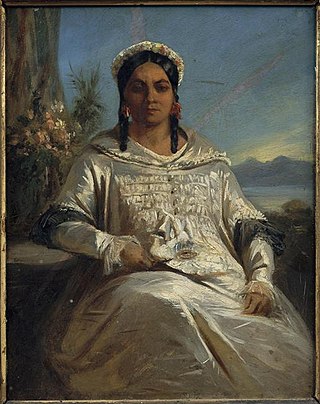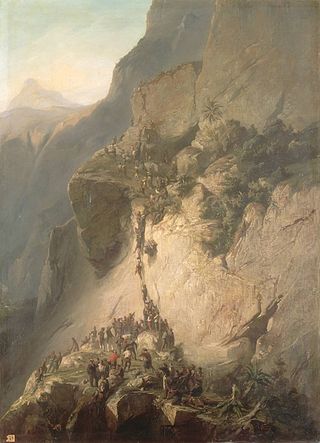Related Research Articles

French Polynesia is an overseas collectivity of France and its sole overseas country. It comprises 121 geographically dispersed islands and atolls stretching over more than 2,000 kilometres (1,200 mi) in the South Pacific Ocean. The total land area of French Polynesia is 3,521 square kilometres (1,359 sq mi), with a population of 278,786 of which at least 205,000 live in the Society Islands and the remaining population lives in the rest of the archipelago.

Tahiti is the largest island of the Windward group of the Society Islands in French Polynesia. It is located in the central part of the Pacific Ocean and the nearest major landmass is Australia. Divided into two parts, Tahiti Nui and Tahiti Iti, the island was formed from volcanic activity; it is high and mountainous with surrounding coral reefs. Its population was 189,517 in 2017, making it by far the most populous island in French Polynesia and accounting for 68.7% of its total population; the 2022 Census recorded a population of 191,779.

The Marquesas Islands are a group of volcanic islands in French Polynesia, an overseas collectivity of France in the southern Pacific Ocean. Their highest point is the peak of Mount Oave on Ua Pou island, at 1,230 m (4,035 ft) above sea level.

The history of the Pitcairn Islands begins with the colonization of the islands by Polynesians in the 11th century. Polynesian people established a culture that flourished for four centuries and then vanished. They lived on Pitcairn and Henderson Islands, and on Mangareva Island 540 kilometres (340 mi) to the northwest, for about 400 years.

Moʻorea, also spelled Moorea, is a volcanic island in French Polynesia. It is one of the Windward Islands, a group that is part of the Society Islands, 17 kilometres (11 mi) northwest of Tahiti. The name comes from the Tahitian word Moʻoreʻa, meaning "yellow lizard": Moʻo = lizard ; Reʻa = yellow. An older name for the island is ʻAimeho, sometimes spelled ʻAimeo or ʻEimeo. Early Western colonists and voyagers also referred to Moʻorea as York Island or Santo Domingo.

Pōmare IV, more properly ʻAimata Pōmare IV Vahine-o-Punuateraʻitua, was the Queen of Tahiti between 1827 and 1877. She was the fourth monarch of the Kingdom of Tahiti.

Faʻaʻā is a commune in the suburbs of Papeʻete in French Polynesia, an overseas country of France in the Pacific Ocean. Faʻaʻā is located on the island of Tahiti, in the administrative subdivision of the Windward Islands, themselves part of the Society Islands. At the 2022 census Faʻaʻā had a population of 29,828, making it the most populous commune on Tahiti and in French Polynesia. Faʻaʻā has many mountains inland that can reach 1,500 m (5,000 ft). Mount Marau is an extinct volcano in the inland limits and can be seen from nearby Moʻorea. The area of Faʻaʻā is 9 m (30 ft) above mean sea level on average.
Rimatara is the westernmost inhabited island in the Austral Islands of French Polynesia. It is located 550 km (340 mi) south of Tahiti and 150 km (93 mi) west of Rurutu. The land area of Rimatara is 8.6 km2 (3.3 sq mi), and that of the Maria islets is 1.3 km2 (0.50 sq mi). Its highest point is 106 m (348 ft). Its population was 872 at the 2017 census.

The Society Islands are an archipelago in the South Pacific Ocean that includes the major islands of Tahiti, Moʻorea, Raiatea, Bora Bora and Huahine. Politically, they are part of French Polynesia, an overseas country of the French Republic. Geographically, they form part of Polynesia.

Alexander Ariʻipaea Vehiaitipare Salmon Jr. (1855–1914) was the English-Jewish-Tahitian co-owner of the Maison Brander plantations on Tahiti and de facto ruler of Easter Island from 1878 till its cession to Chile in 1888.

The Tahitians are the indigenous Polynesian people of Tahiti and thirteen other Society Islands in French Polynesia. The numbers may also include the modern population in these islands of mixed Polynesian and French ancestry. Indigenous Tahitians are one of the largest Polynesian ethnic groups, behind the Māori, Samoans and Hawaiians.
The Democratic Rally of the Tahitian People was a political party in French Oceania/French Polynesia. The party was led by Pouvanaa a Oopa.

The Kingdom of Tahiti or the Tahitian Kingdom was a Polynesian monarchy founded by paramount chief Pōmare I, who, with the aid of British missionaries and traders, and European weaponry, unified the islands of Tahiti, Moʻorea, Teti‘aroa, and Mehetiʻa. The kingdom eventually annexed the Tuamotus, and the Austral Islands.

The Order of Tahiti Nui was established on 5 June 1996 by the Assembly of French Polynesia to reward distinguished merit and achievements in the service to French Polynesia.
The Pōmare dynasty was the reigning family of the Kingdom of Tahiti between the unification of the islands by Pōmare I in 1788 and Pōmare V's cession of the kingdom to France in 1880. Their influence once spanned most of the Society Islands, the Austral Islands and the Tuamotu Archipelago.

Johanna Marau Taʻaroa a Tepau Salmon was the consort of King Pōmare V who ruled from 1877 to 1880 and was the last queen consort of the Kingdom of Tahiti. Her name means "Much-unique-cleansing-the-splash" in the Tahitian language.

The Church of Jesus Christ of Latter-day Saints had its first presence in French Polynesia in 1843 when the first missionaries arrived in the country. It was also the location of the first foreign-language mission of the church which was created that same year. It existed until 1852 when it was closed due to restrictions by the French government, and the missionaries left the territory. In 1892, the mission resumed with the return of the missionaries after general religious tolerance was established.

Alexander Salmon was an English merchant who was the first Jew to reside in Tahiti. He became secretary to Queen Pōmare IV and married her adopted half-sister. Through his daughter's marriage to John Brander his family formed part of the influential Salmon/Brander Clan of Tahiti.

The Franco-Tahitian War or French–Tahitian War (1844–1847) was a conflict between the Kingdom of France and the Kingdom of Tahiti and its allies in the South Pacific archipelago of the Society Islands in modern-day French Polynesia.

The annexation of the Leeward Islands or the Leewards War was a series of diplomatic and armed conflicts between the French Third Republic and the native kingdoms of Raiatea-Tahaa, Huahine and Bora Bora, which resulted in the conquest of the Leeward Islands, in the South Pacific archipelago of the Society Islands in modern-day French Polynesia.
References
- 1 2 "Tahiti". Jewish Virtual Library . Retrieved 2013-11-19.
- ↑ Comay, Joan (1974), Who's who in Jewish history : after the period of the Old Testament, Weidenfeld & Nicolson, ISBN 978-0-297-76572-1
- ↑ Ex-Queen of Tahiti Archived 2019-02-03 at the Wayback Machine Pacific Islands Monthly , March 1935, p16
- ↑ "La communauté juive de Tahiti fête Hanoucca" (in French). TNTV News. 15 December 2018. Retrieved 18 July 2023.